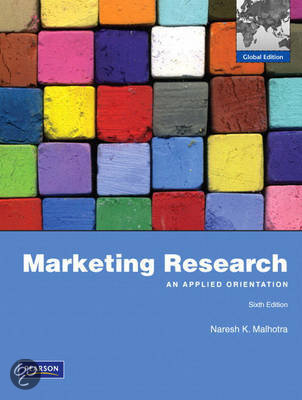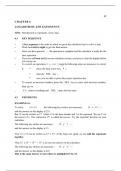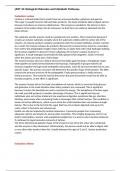Lecture 1: Introduction, Factor Analysis
• This course is about questions & answers, NOT methods.
• Data analysis = means to an end. More important is telling the story, and being able to
interpret the outcome. Your ‘‘grandma’’ should be able to understand it; this gives you
points.
• Different scales for surveys:
o One-item; yes/no, age, gender, etc.
o Multi-item; attitudes, lifestyles, etc. Be careful not to include too many items.
• What if you have too many items?
o Factor Analysis: defining all questions of the survey in factors (price, service,
location, etc.)
o Reliability Analysis
▪ Both for data reduction, especially useful for multi-item scales.
• Data analysis basic steps:
o Inspection & preparing data for final analysis.
o Final analysis: testing hypotheses, regression, etc.
▪ Is there crap in your data initially? Then crap will come out. Crap in =
crap out.
• Factor Analysis: reduction of large quantity of data by finding common variance.
o To retrieve underlying dimensions in a dataset.
o To test if hypothesized dimensions actually exist in a dataset.
▪ No distinction will be made here at first between dependent and
independent variables = no causal relation in the first stage.
o Data reduction; n items -> summarize items in p < n factors, to achieve
parsimony: explaining a lot with little; the amount of information is the same
only with less variables. Also, there will be less multicollinearity after factor
analysis.
▪ Variables will be expressed as a linear combination of other variables,
called factors; x1 -> F1. Only choose the strongest factors. But; the
fewer factors you obtain, the less information.
▪ F1 -> x1, x2, x3. F2 -> x4, x5, x6, and so forth.
▪ Matrix form:
▪ F1 = w11x1 + w12x2 + …
▪ F2 = w21x1 + w22x2 + …
▪ Items = variables = survey questions.
▪ Dimensions = factors = components.
1
,o Factor Analysis in SPSS:
▪ 1) Research purpose: what variables to include?
• Easier if you have a certain hypothesis.
▪ 2) Is Factor Analysis appropriate?
• KMO (Kaiser-Meyer-Olkin) test; will data factor well?
If KMO < 0.5, drop variable with the lowest KMO.
• Bartlett’s test; H0; variables are uncorrelated. If we cannot
reject H0, no correlations can be established.
• Communalities; percentage of variance of a given variable
explained by all extracted factors. Should be < 1, but larger than
0.4.
▪ 3) Select factor model to achieve weights wij:
• Principal component analysis (PCA).
• Common factor analysis (not being done in this course).
▪ 4) Select best number of factors; check the output.
• Ignore factors which have less significance (less variance),
based on one or more of the following methods:
o Choose those which have eigenvalues of > 1.
o Look at total explained variance to be > 60%
(cumulative).
o Look at factors that explain > 5% each (non-
cumulative).
o Inspect scree plot, which is a graphical representation;
where is the drop in the line? Include variables before
this drop.
▪ In any case, better include too many variables
than too few variables.
▪ 5) Rotate factor matrix in SPSS.
2
,Lecture 2: Factor Analysis, Reliability Analysis, Cluster Analysis
• Step 5 of Factor Analysis: Rotate factor matrix in SPSS.
o ‘‘Cleaning the window’’; prevents that all variables load in 1 factor; minimizes
number of variables with high loadings, but does not change explained
variance.
▪ High loading = strong connection to one dimension (not more than one
dimension, otherwise this might be an indication that your factors are
not good.
• 6) Interpreting & labelling factors that have rotated loadings of > 0.5.
o Eigenvalue = how much variance is explained by a factor?
o Communality = how much variance is explained of a variable? More factors =
more communality.
▪ F1 F2
▪ X1 X1 Communality
▪ X2 X2
▪ X3 X3
Eigenvalue
o Cross-loading = variables having high loadings to more than one factor;
reduce the number of factors or variables.
• 7) Subsequent use of factors: create new variables, use obtained factors for this.
o 2 ways:
▪ Calculate factor scores for each respondent.
▪ Use reliability analysis.
• Reliability Analysis: when underlying dimensions are known, after using factor
analysis; how strong are these factors?
o Cronbach’s Alpha: measure internal consistency.
• 2 ways of reliability analysis:
o Reliability analysis of scale as found in theory.
o Reliability analysis of factors found in PCA.
• Measurement error = systematic error + random error.
o Reduce the systematic error. An analysis can still be reliable if there is a
consistent systematic error! There is only a problem if it is inconsistent.
• For step 7 of Factor Analysis, use Cronbach’s Alpha.
o CA should be higher than 0.6.
▪ Too low; delete the item.
▪ SPSS will show what CA will look like if one item is deleted.
• If it will appear low, keep the item, if higher, delete it.
• Only 2 items left? Don’t do Cronbach’s Alpha.
3
, • Data analysis with a spatial map:
o 1) Let many consumers rate n brands on m attributes.
o 2) Reduce m variables to a lower number of dimensions, preferably 2 (using
FA).
o 3) Check internal consistency with Cronbach’s Alpha.
o 4) Compute average scores on dimension or factor per brand.
o 5) Plot (in Excel).
• Cluster Analysis (STP):
o Segmenting:
▪ Identify segmentation bases.
▪ Develop profiles of resulting segments.
• 1) Rationale for segmentation (strategy): why?
• 2) Select most useful segmentation variables.
• 3) Segment market; select cluster analysis procedure.
o Divide heterogeneous sample in homogeneous groups.
Groups should internally be as similar as possible,
compared to other groups, which should among each
other be as different as possible!
o Active variables = used for clustering.
o Passive variables = used for group identification.
• 4) Group customers in segments.
• 5) Choose segments that best serve firm’s strategy, given
capabilities, skills, competitors.
o Targeting:
▪ Evaluate attractiveness of each segment.
▪ Select target segments.
o Positioning:
▪ Identify positioning concepts.
▪ Select, develop.
o Define measures for similarities of customers, based on their needs.
o Group customers with similar characteristics.
o Select number of segments using numeric & strategic criteria.
o Profile needs of segments.
o Measure -> Group -> Selection of number of segments -> Profile.
o At what moment in time do you start to combine people who are not that
similar anymore?
▪ Use the Agglomeration Schedule. Coefficient = cost of combining.
▪ Use a Dendogram; visual representation.
4











